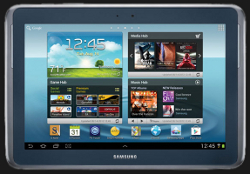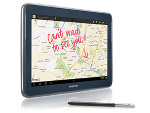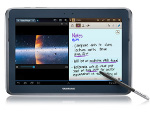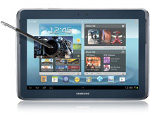Nexus 10 vs Galaxy Tab 10.1 vs Galaxy Note 10.1
Last updated Dec 5, 2012 — 37370 views To find out which 10-inch Android tablet is best, we compare key features and specs of four of today’s most interesting Android tablets: Samsung’s Galaxy Tab 2 10.1 and Galaxy Note 10.1; Google’s Nexus 10 (also manufactured by Samsung); and Lenovo’s IdeaTab S2110.
To find out which 10-inch Android tablet is best, we compare key features and specs of four of today’s most interesting Android tablets: Samsung’s Galaxy Tab 2 10.1 and Galaxy Note 10.1; Google’s Nexus 10 (also manufactured by Samsung); and Lenovo’s IdeaTab S2110.
As you’ll see in a moment, the answer to the question of which tablet is best is highly dependent on your own personal priorities relative to price, performance, screen resolution, and other issues. To get the ball rolling, let’s compare the four tablets’ out-of-box homescreens.




Out-of-box homescreens…
Top row: Galaxy Tab 2 10.1; IdeaTab S2110;
Bottom row: Nexus 10; Galaxy Note 10.1
(click each image to enlarge)
Be careful not to be overly influenced by the tablet manufacturers’ eye candy, which, after all, is simply a matter of how the tablet’s default homescreens are configured. Things like homescreen wallpaper, default widgets and app launchers, and even the homescreen launcher itself are a snap to revise. To prove that, here are the same four tablets following DeviceGuru’s typical homescreen tweaking process (as demonstrated in our tablet reviews)…




Tweaked homescreens…
Top row: Galaxy Tab 2 10.1; IdeaTab S2110;
Bottom row: Nexus 10; Galaxy Note 10.1
(click each image to enlarge)
Not so different any more, are they? OK, so let’s see how their features and specs compare…
Comparison of features and specs
The key features and specs of the four tablets pictured above are compared in the table below. Notable weaknesses are highlighted in red, while stand-out strengths appear in green.
| Galaxy Tab 2 10.1 | IdeaTab S2110 | Nexus 10 | Galaxy Note 10.1 | Processor | 1.0GHz dual-core | 1.5GHz dual-core | 1.7GHz dual-core | 1.4GHz quad-core | RAM | 1GB | 1GB | 2GB | 2GB | Internal flash | 16GB | 16GB or 32GB | 16GB or 32GB | 16/32/64GB | microSD expansion | yes | no | no | yes | OS | Android 4.0 | Android 4.0 | Android 4.2 | Android 4.0 | Apps market | Display | 1280×800 | 1280×800 | 2560×1600 | 1280×800 | Front camera | 0.3MP | 1.3MP | 1.9MP | 1.9MP | Rear camera | 3MP | 5MP | 5MP | 5MP | Video output | yes | yes | yes | yes | WiFi | yes | yes | yes | yes | Bluetooth | v3.0 | v4.0 | v3.0 | v4.0 | GPS | yes | no | yes | yes | Battery | 7000 mAh | 6320 mAh | 9000 mAh | 7000 mAh | Size (in.) | 10.1 x 6.9 x 0.4 | 10.2 x 7.0 x 0.4 | 10.4 x 7.0 x 0.4 | 10.3 x 7.1 x 0.4 | Weight | 21 oz | 21 oz | 21 oz | 21 oz | Price (*) | $350 (16GB) | $340 (16GB) $??? (32GB) |
$400 (16GB) $500 (32GB) |
$500 (16GB) $550 (32GB) |
* Note: Lenovo and Samsung prices were retrieved from Amazon.com on Dec. 11, 2012
Generally, there’s more green and less red as you move from the lower- to the higher-priced tablets. But features and specs aren’t the whole story. Next, let’s consider performance.
Performance benchmarks
We benchmarked each tablet’s CPU, math, graphics, and memory performance using the Android AnTuTu benchmark app. The results, based on AnTuTu version 3, are summarized in the following chart.

Benchmark results
(click image to enlarge)
Note: We only had an original Galaxy Tab 10.1 on hand, so the chart substitutes that tablet’s benchmark data for the Galaxy Tab 2 10.1’s. However, the two versions have nearly identical hardware specs and our v1 Tab is running the same Android 4.0 release as the Tab 2, so their benchmark results can be expected to be very similar.
As expected, faster CPU clock rates, more cores, and increased RAM sizes can provide substantially higher performance. From the benchmark perspective, the Galaxy Note 10.1 is the clear winner, with more than twice the score of it’s lower-priced sibling, the Galaxy Tab 10.1.
And the winner is…
So back to the question of which is tablet is best. The answer depends on how you prioritize price, performance, and features. And when it comes to the latter, a single function might easily become a deal maker or breaker, depending on how you expect to use your tablet. In that regard, here are a few unique features that don’t show up in our table of features and specs:
- IdeaTab S2110 — optionally available with a nifty snap-in keyboard, which morphs it into a hybrid tablet/notebook (see image below); uses standard micro-USB and micro-HDMI for connectors for power and video

(click image to enlarge)
- Nexus 10 — NFC wireless communications; optional magnetic charging; uses standard micro-USB and micro-HDMI for connectors for power and video
- Galaxy Note 10.1 — comes with a snap-in stylus and provides various pen-based capabilities including a multifunction note-taking app that integrates typing, handwriting, embedded images, and embedded audio clips; also comes with a set of “multiscreen” apps, which can be positioned side-by-side on the screen, as well as with “mini” apps that pop up and can be moved around on top of other running apps (see images below demonstrating some of these features).



(click images to enlarge)
To my way of thinking, priced at $400, the Nexus 10 strikes a good balance among features, performance, and cost. You can save money by opting for either the Galaxy Tab 2 10.1 or IdeaTab S2110, but you’ll miss out on the Nexus 10’s super-hi-res 2560×1600 screen and its substantially higher performance.
On the other hand, the Galaxy Note 10.1, which is priced somewhat higher than the Nexus 10, edges out the Nexus 10 in several respects, performance-wise, but lacks the Nexus 10’s superior display. I’ve used both tablets in parallel for several weeks, and although I like the Galaxy Note 10.1 a lot, the Nexus 10 has won me over with its more pleasing look and feel, gorgeous display, and more up-to-date OS. Also, I’m not particularly interested in Samsung’s “innovative” handwriting input and multi-windowing apps. Call me old fashioned, but on my tablets I’d rather type and talk, than scribble and scrawl!
Further info
For more information regarding these tablets’ unique features and capabilities, consult these resources…
- Google Nexus 10:
- Samsung Galaxy Tab 2 10.1:
- Samsung Galaxy Note 10.1:
- Lenovo IdeaTab S2110:
| Be sure to check out DeviceGuru’s continually updated Android tablet comparisons: |
How would the Asus Transformer compare to these?
I would also be interested in knowing how Asus Transformer Infinity compares to these…
Anybody that wants to use a Bluetooth Keyboard with these devices may be better off steering away from the Nexus 10. That has the best screen which I love on mine, but using a Bluetooth Keyboard with this device is very difficult. It should be simple like an i Pad, but it is not. For some reason, the on screen keyboard is embedded and very difficult to override with most programs. Not sure how these other devices work with a Keyboard, but if they don’t then looks like the default tablet should probably be an i Pad.
I recently installed an inexpensive app that provides a widget for switching between the external BT keyboard and the internal on-screen keyboard. I tried a few, but this one seems to work best:
“Bluetooth (Null) Keyboard” by Darken
https://play.google.com/store/apps/details?id=eu.thedarken.nkv2
I haven’t used it a lot yet, but so far it seems to work better than a couple others I’ve tried.